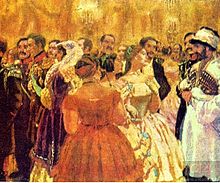Hadji Murat (novel)

The house of Prince Semyon Vorontsov, illustration by Eugene Lanceray
|
|
| Author | Leo Tolstoy |
|---|---|
| Original title | Хаджи-Мурат (Khadzhi-Murat) |
| Translator | Kyril Zinovieff and Jenny Hughes (2011) |
| Country | Russia |
| Language | Russian |
| Genre | Historical fiction |
|
Publication date
|
1912 (posthumously) |
| Media type | |
| Pages | 212 pp (paperback) |
| ISBN | |
Hadji Murat (or alternatively Hadji Murad, although the first spelling better captures the original title in Russian: Хаджи-Мурат [Khadzhi-Murat]) is a short novel written by Leo Tolstoy from 1896 to 1904 and published posthumously in 1912 (though not in full until 1917). It is Tolstoy’s final work. The protagonist is Hadji Murat, an Avar rebel commander who, for reasons of personal revenge, forges an uneasy alliance with the Russians he had been fighting.
Tolstoy seems to have first heard of the historical Hadji Murad while he was serving in the Caucasus, according to letters he wrote to his brother Sergei. The thistle described at the opening of the story was actually encountered by Tolstoy near his country estate and led him to remember the character and create a story about him.
The theme of struggle while remaining faithful resonated with Tolstoy even though he was in ailing health; later letters suggest this work gave him a brief, final moment of vigor. Just as the author was struggling with his near death, his extended meditation on the concept of the individual refusing to give in to the demands of the world helped him to complete the book, although he himself had no inclination to publish it and was only concerned with its completion. In addition to the theme of resistance, there are many other ideas that can be found in the novel, such as determinism; this echoes Tolstoy's major work War and Peace. An even clearer theme is the struggle between a Christian Russia and Muslim Chechnya, the classic West vs. East theme found in Russian history and many different stories and novels (and which is once again pertinent in light of First and Second Chechen Wars in Chechnya and Russia).
The work is very similar to Alexander Pushkin's work The Captain's Daughter in that it is a realist work based on actual people and events and has a similar direction, though the main character in this novel does not meet the same end. Tolstoy used material in Russian archives, including Hadji Murad's own account of his life.
...
Wikipedia
